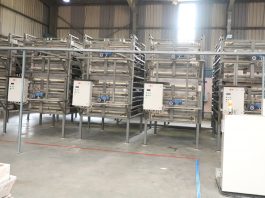At present, each person living in the EU generates 34.6kg of plastic packaging waste a year on average, though only 38% of that is recycled.
In response to the scale and urgency of the EU’s waste problem, the European Commission launched its final proposal on packaging and waste, which, if accepted, will accelerate the EU’s goal to make all packaging reusable or recyclable by 2030.
Poor recycling rates are partly due to the many complexities of recycling certain types and applications of plastic packaging waste. The Food Packaging Forum, for example, deems plastic food-grade packaging as having limited recyclability options.
Besides PET, it reports that most other plastic food packaging is either downcycled or not recycled, citing the lack of waste collection and separation schemes and insufficient decontamination processes.
The EU’s Packaging and Packaging Waste Regulation proposal, has the potential to reduce neither recyclable packaging materials nor recycled at scale and instead work towards a circular economy.
Putting an end to plastic packaging waste
The Packaging & Packaging Waste Regulation is extensive and will transform the trajectory of packaging when passed. It introduces the following requirements:
- Waste prevention: Each packaging unit must be scaled to its minimum size while ensuring functionality and reducing excessive or overpackaging. New waste prevention targets (i.e. packaging waste generated per capita reductions) have been set at the Member State level and are to be met on a five-year basis;
- Recyclability: A new and more stringent definition of recyclability requires that packaging designed for recycling is effectively separated and collected and produces high-quality recyclates that can substitute primary raw materials, among other things. As of 2030, all packaging will receive a recyclability performance grade linked to modulated extended producer responsibility (EPR) fees and market access. Highly recyclable packaging will be rewarded with lower EPR fees; poorly recyclable packaging will incur high EPR fees and may even be banned from the market. As of 2035, all packaging allowed on the market must also demonstrate that it can be recycled at scale;
- Recycled content: A minimum amount of post-consumer recycled content is mandated, but only for plastic packaging (up to 65% by 2040 for certain product types);
- Re-use and Refill: Ambitious targets for reusable and refillable packaging have been set for 2030 and 2040, covering a range of products such as beverages, takeaway food, and transport packaging; and
- Deposit and return systems: By 2029, all member states will have established deposit and return schemes for single-use plastic bottles and metal beverage containers with a capacity of three litres.
Organisations may need to reconsider an extensive section of the packaging process depending on how many products require change. Imagine a brand’s most popular product is no longer in suitable packaging – so as not to incur extra fees, the company will need to plan new packaging ahead of time.
How will the changes affect consumers?
The variety of products in the supermarket can be overwhelming for customers looking to buy an environmentally-friendly product, especially when sustainability claims are confusing or vague.
As the 2023 Buying Green Report identified, nearly half of consumers (46%) say unclear labelling is a barrier to purchasing sustainably. The proposed regulations will make it easier for consumers to shop sustainably, rewarding brands that stay away from hard-to-recycle materials and encouraging additional use of easily recyclable and infinitely recyclable materials that consumers are looking for.
Under the proposed regulation, a certain percentage of primary, secondary, and tertiary plastic packaging waste should be reusable, with targets set for 2030 and 2040. For example, by 2040, more than 80% of cold and hot takeaway beverages filled at the point of sale should be in reusable vessels.
Though this section of regulation has received some criticism, consumers today are keen on such changes. The 2023 Buying Green Report found that 71% of consumers are already engaging in reusing activities, such as reusing shopping bags, bottles, and containers, and 80% of consumers would be interested in buying products in refillable packaging to reduce their environmental impact.
Eager to make an environmentally conscious choice, 71% of consumers have chosen a product in the last six months based on its sustainability credentials, showing that brands have an opportunity to drive demand while making sustainable decisions.
When it’s passed, the regulation will make it much easier for sustainably conscious shoppers to purchase products in packaging that aligns with their values. In addition, a new proposal announced in March 2023, ‘Directive on Green Claims’, will help consumers make informed decisions by making sustainable claims more reliable through science-back verification. Crucially, both proposals will help the consumer feel confident that the packaging is genuinely recyclable and abides by stricter regulations.
How will the regulation reduce pollution?
Above all, the packaging brands develop for their products must be durable, robust and protective as well as preserve its content, and depending on the product, the right material for this will vary.
However, choosing an infinitely recyclable material will be the best bet for brands looking to ensure their packaging will stand the test of time in the face of changing regulations.
If brands collectively shift towards infinitely recyclable options, the amount of unusable waste produced yearly will quickly fall, with circularity moving to the forefront. For example, in the case of metal, 75% of aluminium ever produced is still in use today and steel is recorded as the most recycled material globally.
We face a growing problem, with plastic packaging waste ending up incinerated, in landfill, or polluting our environment and oceans. However, this legislation marks the beginning of positive change for the EU in favour of a circular economy and the environment.










